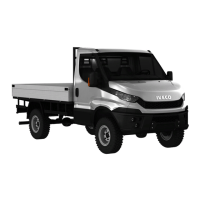DAILY 4x4 ‒ GUIDELINES FOR BODYBUILDERS
CHASSIS INTERVENTIONS
2.3 RUST AND PAINT PROTECTION
13
– Printed 692.68.999 – 3 Ed. - Base 08-2020
2.3.3 Precautions
a) On the vehicle
Appropriate precautions must be taken to protect parts on which paint could be harmful to the conservation and operation
thereof:
● hoses for pneumatic and hydraulic systems in rubber or plastic, with particular reference to the braking system;
● gaskets, rubber or plastic parts;
● propeller shaft and PTO flanges;
●
radiators;
● suspension, hydraulic/pneumatic cylinder stems;
● air vent valve (mechanical assembly, air tank, thermostarter preheat tanks, etc.)
● sediment bowl and fuel filter assembly;
● plates, codes.
If painting is required after wheels are removed, it is necessary to:
● Protect the wheel rim mounting surfaces on the hubs and the contact areas of the locking lugs/wheel studs;
● ensure adequate protection of brake discs.
The electronic components and modules must be removed.
b) On engines and their electric and electronic components
Appropriate precautions must be taken to protect:
● engine wiring and ground contacts;
● the sensor/actuator side connectors and wiring side;
● the sensors/actuators on the flywheel and on the flywheel rpm sensor mounting bracket;
● pipes (plastic and metal) of the fuel circuit;
● complete basic diesel filter;
● the ECU and its base;
● the entire internal part of the sound-proof cover (injectors, rails, pipes);
● the common rail pump and its control valve;
● the vehicle electric pump;
● tank containers;
● the front V-belts and relative pulleys;
● the power steering pump and relative pipes.
Note
When the painting operation has been completed, and prior to oven drying (max. temperature 80
°
C), all parts which may be
damaged by exposure to heat, must be removed or protected.

